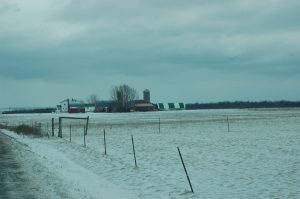By Paige Smart, Southeast AgriSeeds
There is little doubt that this winter will be a challenge to cattle producers throughout the southeastern states. The limited fall growth due to either extreme drought or extreme flooding has limited the ability to stockpile forage for the winter and has left many feeding hay already. These unfortunate conditions, paired with the limited hay production in late summer, are setting many producers up for a nasty winter. This will become most apparent in spring, when the flush of cool season weeds shows just how much damage pastures took during the winter months. Although damage to pasture during a “perfect storm” year like this one is unavoidable, you can minimize your losses.
Identify a sacrifice pasture. Treat your pastures like your cow herd- each year, cull the lowest producers. Just as with your cow herd, pasture culling decisions should be based on man y factors. This could include the weed pressure in the pasture, it’s production or lack thereof, or the species composition, such as KY-31 Fescue. Determine which factors are most important to your operation, and pastures lacking in that area can be designated as your sacrifice area. Keep cattle in this area when feeding hay or commodities, and allow them to tread the land. This will begin to destroy the existing pasture, making room for you to begin its renovation process. Depending on the size of your herd, you may need to identify several sacrifice areas so that animal health doesn’t become compromised.
y factors. This could include the weed pressure in the pasture, it’s production or lack thereof, or the species composition, such as KY-31 Fescue. Determine which factors are most important to your operation, and pastures lacking in that area can be designated as your sacrifice area. Keep cattle in this area when feeding hay or commodities, and allow them to tread the land. This will begin to destroy the existing pasture, making room for you to begin its renovation process. Depending on the size of your herd, you may need to identify several sacrifice areas so that animal health doesn’t become compromised.
Set a long term goal. Think about your grazing pattern in a year. Where do you find yourself lacking in forage production? Determine if it would benefit you most to establish a warm or a cool season forage. Do you have the flexibility or to keep the acreage in annuals, or do you need to have more perennial forage? Do you want to build your soil health, reduce the weed seed bank, or increase your pasture diversity? Also think about the nutritional requirements of your livestock. If you find yourself feeding large quantities of supplements, consider using annuals to increase the overall protein and energy of your forage system. Think through these questions and set a long term goal for the area. Without setting this long term goal, it will be difficult to determine how to deal with the pasture in the short term. Keep in mind the constraints of your farm when setting this goal.
Have a short term plan. Due to the nature of sacrificed pastures, there’s no doubt it will be looking pretty rough in the spring. No matter if your long term plan includes annuals or not, including them in the short term plan is critical. Due to the quick germination and flush of growth annuals have, they are going to be your best tool for getting the sacrifice area back under control. Is the pasture overrun with weeds? Planting a simple annual mix (without legumes or brassicas) will allow you more flexibility with tackling weeds by spraying throughout the growing season. Does the area lack organic matter? Consider a diverse annual that will leave behind a lot of residue for building topsoil. When seeding using a no-till drill, areas with significant treading may need to be smoothed out prior to the first planting to ensure good seed to soil contact. Depending on your long term goal, you may need to leave the land in an annual rotation for 1-2.5 years. In most cases, having annuals in pasture for at least one year will give you better control of any subsequent perennial seedings.
It can be difficult to make investments in a year like this, when cattle prices are low and hay prices are high. However, the value of having a strong stand of forage will really become apparent in times like this. I encourage you to think about your pastures as you do your cow herd. With good management, culling your lowest performing acreage each year will result in greater forage production and lower your reliance on stored forages or commodity feeds.
Speak to an expert at King’s AgriSeeds now at 1-717-687-6224 or email us at [email protected].
